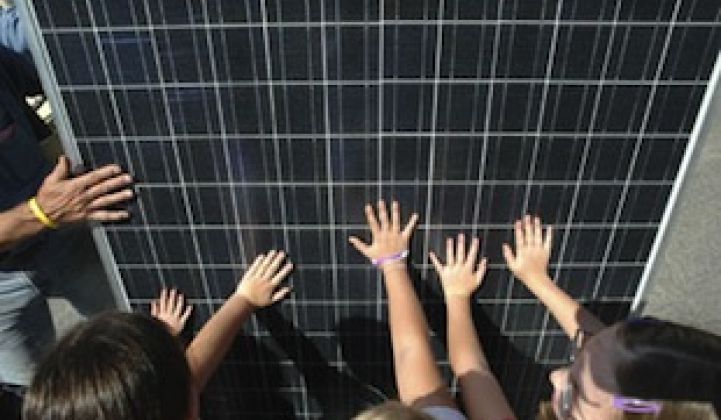On March 11, a small elementary school district in Salinas, California took a big leap forward: with a unanimous vote, the school board approved financing for the installation of solar panels on all thirteen of its schools.
What the Salinas school board recognizes -- and what many researchers have concluded -- is that structural investments in schools are investments in the students who reside in them; largely through reinvested savings in education and learning environments, we invest in human capital for the next generation.
In fact, given the current debate around proposed funding models for Proposition 39 (the ballot proposition that raised corporate tax revenue for energy-efficient school construction), the project in Salinas can help shed some light on what these investments could do for schools around the state.
A Plan That Works
With an initial investment of $7 million, proposed as a loan by Chevron Energy Solutions from Green Campus Partners LLC, the solar panel installation in Salinas is expected to produce about 1.6 million kilowatt-hours of energy in the first year. This amounts to nearly 70 percent of the elementary schools’ total energy consumption, or $300,000 in lower energy bills each year.
After balancing loan payments with energy rebates, credits, and savings from the California Solar Initiative, the school district is projected to pocket $12,000 to $50,000 in annual savings -- up to $1.1 million annually when the loan is repaid.
With the money wisely invested, the district’s roughly 8,500 students will benefit. The Salinas School District will be able to re-invest these savings in to teacher salaries, educational supplies, or other delayed construction projects in the district. This model fits what the Center for Green Schools call for in its recent report, noting that “increase[d] energy efficiency [will...] save taxpayer dollars and put money back into the classroom where it belongs.”
And these savings are sorely needed for students in the Salinas school district.
District Poverty a Major Concern
Of the total student population in the elementary district, 28 percent come from families living in poverty and a full three quarters of students qualify for free or reduced-price lunches. These students are the definition of “at-risk” youth, and every dollar that can be invested in them now improves their chances of escaping poverty later.
In examining childhood poverty in Salinas as part of a PBS special earlier this month, Ann O’Leary, Vice President at Next Generation, put it simply: “One of the ways to [truly] disrupt poverty…is to provide these children with a good education,” since deep poverty and later academic success are so closely correlated.
Given that the poverty rate among Hispanic and Latino children in California is nearly one in three, even as this group has become the majority of children in the state (the Hispanic population in Salinas’ elementary schools reaches a whopping 86 percent), investments in their educational success is an urgent priority.
However, the savings for these investments are not always guaranteed.
Private Money the Only Option
Private financing (the kind used in the Salinas plan) can be incredibly expensive, particularly if costs balloon and are passed along to future generations. While the Salinas plan is relatively safe, public financing offers lower interest rates that can protect potential savings down the road.
Yet, according to Assistant Superintendent Jerry Stratton, the reason the board opted for private financing is that every local and state funding option is currently closed.
After the recession decimated housing value in Salinas, school administrators were left with little working capital from the voter-approved bond passed in 2008. Even at the state level, programs like the Energy Conservation Assistance Act’s (ECAA) low-interest loans are over-subscribed, intermittently funded, and are no longer taking on projects.
Expand Public Investments
This is all the more reason for citizens and legislators to join forces and accomplish a goal that opinion-makers support: allocating Proposition 39 funds -- over half a billion dollars annually -- directly toward renewable and energy efficient improvements in school districts where the need is greatest.
Energy cost-savings from these projects can be re-invested in children, allowing schools to restore threatened curricula, buy new textbooks, and hire additional teachers, increasing a school’s capacity to deliver a quality education at the best possible price; a principle overwhelmingly endorsed by California voters.
Small steps like these help reverse disturbing trends in public education financing nationally, given that school construction will require half a trillion dollars in investment in the next decade.
We hope leaders in California will use Proposition 39 to make it easier for schools across the state to replicate the type of forward-looking program happening right now in Salinas.
***
James Barba is Program Coordinator for the Energy & Climate Program at Next Generation; Reynaldo Fuentes is a Research Associate with the Children & Families Program at Next Generation. Next Generation promotes solutions to two of the biggest challenges confronting the next generation of Americans: the risk of dangerous climate change and the threat of diminished prospects for children and families.
